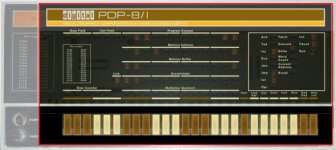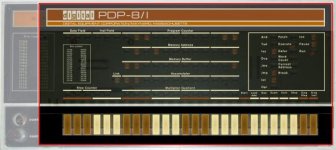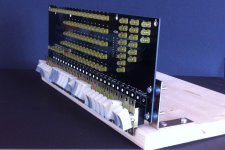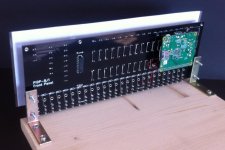Oscar
Experienced Member
Hi,
I'm designing a front panel for a PDP-8/I replica project. This will be a low-cost replica, but I'd still like to make it as faithful to the original as the budget allows.
Below is what I have so far: a PCB plus the acrylic front cover I designed for it.
My problem: I've never seen a PDP-8/I in real life. It proves very hard to establish the correct colors from the various photos I found off the web.
So, the question is, can anyone with access to a real 8/I perhaps help me judge the colors? Most practical is maybe if I can send a picture with a range of color variants to pick from.

Details: the idea is to plug a Raspberry Pi running a modified simh into this PCB. The Raspberry GPIO drives an array of multiplexed LEDs and switches. The picture shows the front panel artwork slightly translucent, so you see my PCB and a real PDP-8/I shining through it. The glowing lights are on the real PDP-8/I, the dimmed LEDs are on my PCB behind the front panel artwork.
I got the panel to be more or less pixel-perfect versus the originals. Except that I am committing sacrilege by rescaling the unit 2:3, and by chopping off the part of the real PDP-8/I outside of the red box - this keeps the cost of the acrylic front panel well below $40. The switches will not be the authentic ones either, but comfortable to work on.
So I guess my question is, would a fortunate 8/I owner help me judge the colors (the brown, yellow especially)?
Kind regards,
Oscar.
I'm designing a front panel for a PDP-8/I replica project. This will be a low-cost replica, but I'd still like to make it as faithful to the original as the budget allows.
Below is what I have so far: a PCB plus the acrylic front cover I designed for it.
My problem: I've never seen a PDP-8/I in real life. It proves very hard to establish the correct colors from the various photos I found off the web.
So, the question is, can anyone with access to a real 8/I perhaps help me judge the colors? Most practical is maybe if I can send a picture with a range of color variants to pick from.

Details: the idea is to plug a Raspberry Pi running a modified simh into this PCB. The Raspberry GPIO drives an array of multiplexed LEDs and switches. The picture shows the front panel artwork slightly translucent, so you see my PCB and a real PDP-8/I shining through it. The glowing lights are on the real PDP-8/I, the dimmed LEDs are on my PCB behind the front panel artwork.
I got the panel to be more or less pixel-perfect versus the originals. Except that I am committing sacrilege by rescaling the unit 2:3, and by chopping off the part of the real PDP-8/I outside of the red box - this keeps the cost of the acrylic front panel well below $40. The switches will not be the authentic ones either, but comfortable to work on.
So I guess my question is, would a fortunate 8/I owner help me judge the colors (the brown, yellow especially)?
Kind regards,
Oscar.



